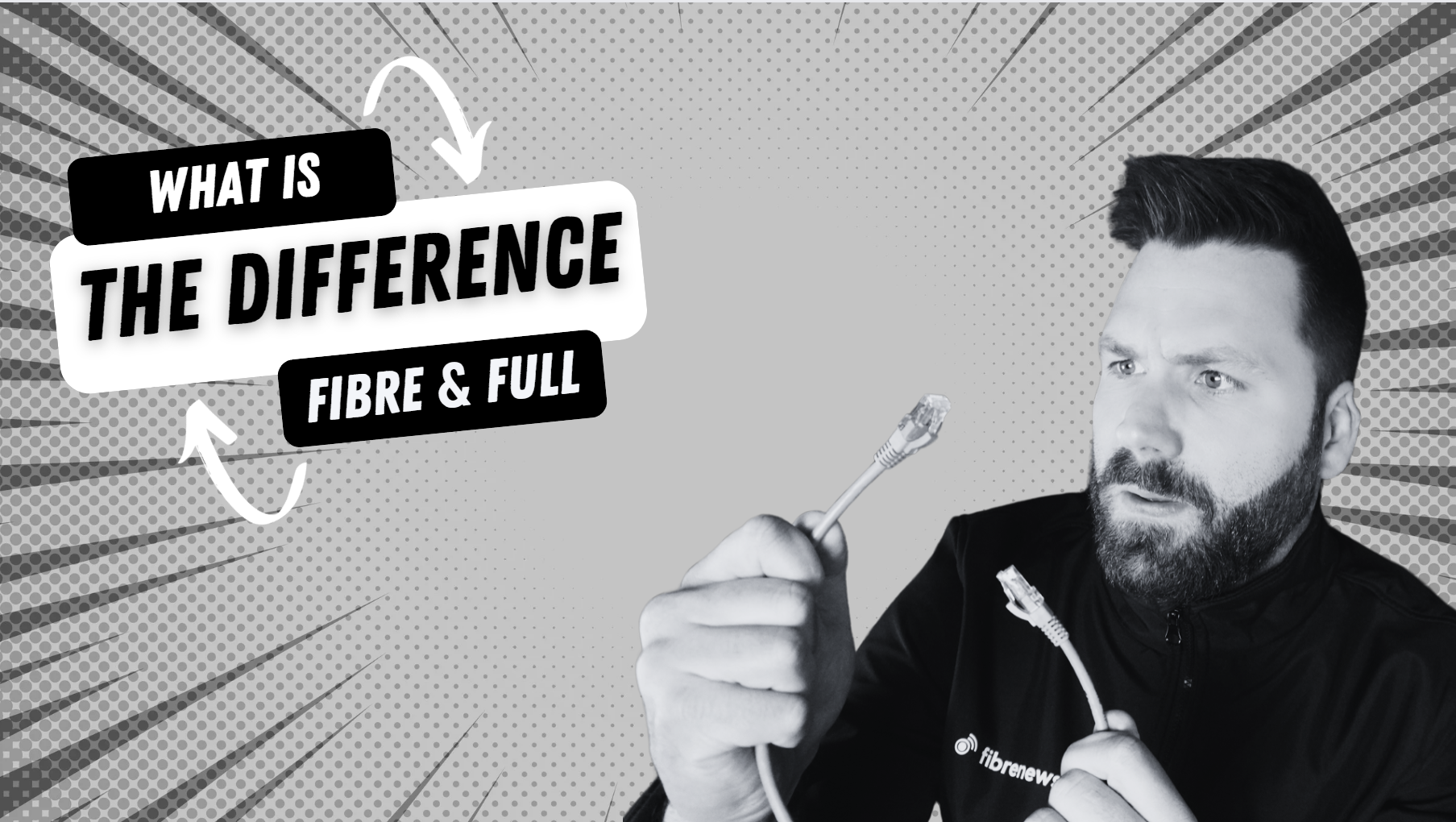In the UK, it’s not clear what the difference is between fibre and full fibre, and that’s not the consumers’ fault. When we first rolled out fibre in the UK, we should have been shouting from the hill tops that we’re rolling out “part fibre” or “fibre to the cabinet” or “nearly fibre”.That’s where the problem begins. When fibre was first introduced, it was put in the cabinet at the end of your road! Not to your home.
Introduction
First, let’s understand what names are often used for fibre and full fibre…
Fibre: “Part fibre,” “FTTC (Fibre to the cabinet),” “SoGEA (just FTTC without a phone service),”
Full Fibre: “FTTP (fibre to the premises)”, FTTH (fibre to the home), “Superfast Fibre”
Now, let’s crack on (FYI, there’s a short video that gives my untechnical explanation to this at the bottom of the article).
The terms ‘fibre’ and ‘full fibre’ are often used interchangeably, yet they represent distinct types of internet connectivity. Both have different speeds and reliability. Fibre (part fibre) internet, a significant step up from complete copper services (ADSL), still combines older technology with new fibre infrastructure. In contrast, Full Fibre, also known as fibre to the home (FTTH), offers a pure fiber-optic connection directly to your doorstep, eliminating any reliance on outdated networks (copper).
This subtle but critical difference has far-reaching implications for internet users, especially as the demand for Super Fast Internet and reliable connectivity skyrockets. In simpler terms, everyone wants the fastest, most reliable internet connection because we’re bandwidth-hungry people.
An Overview of Fibre Technology
Fibre internet connections represent a significant leap forward from traditional broadband. They use fiber-optic cables, which transmit data as light signals, allowing for higher speeds and a more reliable service than metal wire-based connections (copper). The core of these cables is made from glass, providing an avenue for data to travel with less resistance and over greater distances without degradation. Basically, fibre allows speeds up to 10GB+. Copper will panic at 80Mbps.
The term ‘fibre’ often refers to a setup where fibre cables run to a central point (a green street cabinet) in a town or village. From there, data is transferred to individual homes via copper cables (either on telegraph poles or underground)—this configuration is also known as fibre to the cabinet. While this hybrid approach still offers fast-ish broadband speeds, it doesn’t match the pure fibre-optic connection found in full fibre setups, where the fibre link extends all the way into the home.
The Advantages of Full Fibre Connections
Full fibre connections offer several advantages over fibre broadband options. Primarily, they provide considerably higher speeds (10GB+), which is essential for bandwidth-heavy activities like online gaming, streaming video content, and large file transfers. The fast broadband capabilities of full fibre ensure that these activities can be enjoyed without the frustration of buffering (mood killer) or interruptions.
Now, full fibre connections are more reliable than copper-based alternatives (ADSL & Fibre/PartFibre/FTTC). They are less susceptible to environmental factors like temperature changes, water, and electromagnetic interference, which can negatively affect the signal quality of copper cables. This increased reliability means fewer outages and consistent performance. Never lag in Warzone again. Never buffer whilst you netflix and chill.
The Emergence of Full Fibre
Full Fibre broadband has been gaining attention as a game-changing solution to internet connectivity. This technology, also known as fibre to the premises, provides a direct fiber-optic connection to residential and business premises, bypassing any legacy copper networks. The emergence of full fibre is a response to the increasing demands of modern society, where super fast internet has become a necessity for everyday activities and business operations.
There are a boatload of network providers laying new fibre cable to bring the nation up to a full fibre country, including BT/Openreach, City Fibre, Netomnia (YouFibre), Trooli, Gigaclear, Brsk, Ogi, and many more. We’re currently in a full fibre revolution. Fifty per cent of the nation has coverage, and we have another 50% to go. So, if you haven’t yet got full fibre, you may have soon. You can check your full fibre coverage here.
The full fibre rollout marks a pivotal shift in how internet services are delivered and consumed. With the promise of gigabit speeds and improved reliability, full fibre is set to redefine the standard for broadband internet and is central to the future of digital connectivity.
Fibre vs. Full Fibre: The Key Differences
Speed is a primary differentiator when comparing fibre and full fibre internet services. Standard Firer connections, such as Fibre-to-the-Cabinet (FTTC), typically offer fast broadband speeds suitable for most households and small businesses. However, these are often capped at around 80mbps, and the speed varies depending on how far you are from your town exchange. If you’re on a farm in the middle of nowhere, you’re lucky to get a few Mbps because the further the bandwidth, the more it deteriorates.
In contrast, full fibre broadband, or fibre to the home, provides a direct fiber-optic connection to the user’s premises, which can deliver much higher speeds. Full fibre connections, such as ones from BT, TalkTalk, Virgin & SKy, will give you up to 1GB. Other full fibre providers, like YouFibre, are trialling 5GB+ packages. This allows users to enjoy not just faster downloads and uploads but also a more responsive and smoother internet experience, particularly for high-demand activities like streaming ultra-high-definition content, competitive online gaming, and operating multiple smart home devices.
As demand for faster and more reliable internet continues to grow, the difference in speed between fibre and full fibre becomes increasingly significant, making full fibre the preferred choice for users seeking the highest performance.
Check to see if you can get Full Fibre here.
